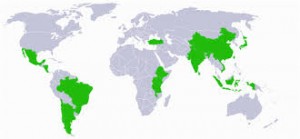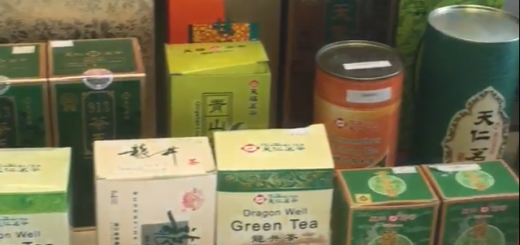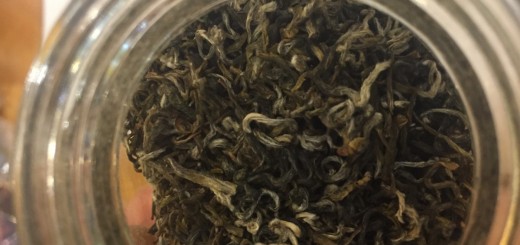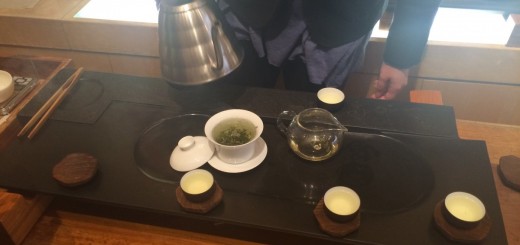Natural History of Tea
Camellia sinensis is a plant that is commonly used throughout the world. Most households refer to this plant by a multitude of other names. It is known globally and most commonly as the tea plant. Camellia sinensis is an evergreen shrub, also referred to as a small tree. This tree can typically live anywhere from 30-50 years if not removed or replaced. Trees typically used in tea production are about 2 M tall due to pruning. If left untrimmed they can grow to around 17 M high. Camellia sinensis produces vibrant green leaves that have a waxy shiny top and fuzzy underside with serrated edges. These leaves are relatively small in comparison to other tea producers, such as Assam tea, but when unattended can grow to about 2 inches long. The scented flowers produced are white with vibrant yellow stamens. The flowers are often grown individually or in clumps of two or four scattered throughout the plant. Round shaped seeds are produced within a small fruit on the tree that has a hard green shelled exterior.
The native geographic range for Camellia sinensis growth is in Southern Asia. It is found growing in Tibet, China, and Northern India. There is also an Assamica strain of Camellia Sinensis, native to the Assam region of India, but this strain has also been found natively growing in China. Although tea can still be grown in these regions, it can also be grown in non-native geographic ranges. With new technologies tea plants can be grown virtually anywhere but it thrives in its original native geographic ranges. The main areas of growth are between the 33 South parallel and the 42 North parallel. This wide range is made possible by cross pollination, done mechanically. This makes the range for cultivation diverse in many ways regarding fields, soil content and climate.
Soil properties and climate are huge factors in the growth and cultivation of Camellia sinensis. Soil properties can vary, but most cultivated ranges are slightly stony, it is most beneficial if the soil is more gravelly. Soils with small amount of sand or medium loamy soils that are well drained also act as very beneficial properties for growth. The preferred soil for beneficial growth is one that is very moist. Although Camellia sinensis can grow in acidic soils, it prefers those with a more neutral pH balance between 4.5-6.0. Lightly wooded areas with semi shade have proven to be great growing conditions for the tea plant. Camellia sinensis flourishes on the edges of woodlands, especially if there is sufficient shading. This is why the plant is often seen growing on hillsides, as optimal elevation is between 2100-2700 M. The optimal climates are tropical and subtropical because the plants have no tolerance to frost. There must be a nice ratio of shade to sunlight with an abundance of rain at about 80-100 inches per a year. The weather needs to be warm and humid for the best growth and flavor. Monsoons, which happen often in tropical climates, make the plant grow at a rapid rate, but this also causes the tea to be less flavorful when produced into a final product.
Propagation for Camellia sinensis is quite tedious. It all starts with the seed which is chosen by being put into water for 30 minutes; whichever seeds sink to the bottom are chosen for planting and deemed good. To continue the process, seeds are placed between two damp cloths for germination. The seeds that germinate are then transferred to a nursery bed where they are left to grow for 2-3 years. During this period their growth will be monitored until they reach a point where they can be transplanted to the field. They are pruned back to a height of 6 Inches before transported to the fields. The leaf trimmings are then used to start other fields and grow more plants. The single node stems are then transferred with the stem firmly pressed into the soil and placed into the bags. The bags are placed in a sheltered area from the sun and watered on a regular basis to promote growth. At this point, young tea plants produced from rooted cuttings are planted in a field for a time span of 6-9 months. The plants are often in the formation of hedges or single and double rows. Contour rows are extremely prevalent in sloped fields. The tea plants are then planted in fields among legumes and grasses which preserve the soil’s moisture and reduce erosion, making it a prime soil for tea growth. As a finisher, the plants are placed about 2 feet apart with 5 feet between each row. This gives each plant a sufficient amount of room for growth.
Once the tea is ready to be harvested the “plucking” process begins. During this process workers (most commonly by hand) pluck the terminal bud and the two leaves growing below it. This is referred to as fine plucking; if the third leaf growing below the bud is picked, then it would be referred to as coarse plucking. The youngest leaves are the most sought after because they obtain the best flavor, although the course plucking process yield better production because it produces more, but lowers the overall quality of the product. The precise process in which the workers use is a motion of using their thumb and forefinger to grasp the plant and pluck the delicate younger leaves. The harvesting usually takes place every 7-14 days depending on the altitude and growth of the plants.
There are many major pests and diseases that threaten tea plantations and their crops of Camellia sinensis. Their careful propagation and daily general care and maintenance of the plantation and fields often work to reduce the risks of their crops getting infected. The major threats to the crops are Camellia Die-back and Canker, which is a fungus that can infect the plant through wounds. The acidic soil is a great natural defense against this fungus along with the daily care of removing branches that have died or been trimmed. Root Rot is also a common and threatening disease to Camellia sinensis crops. It is an extremely dangerous disease caused by oomycete. The best defense against this disease is isolating healthy plants from those that are infected. Tea Scale is another threat to tea plants, it is an insect that causes leaves to turn brown and drop prematurely. The best action to take against this type of infestation is to scrape them off the plants and destroy them or use horticulture oil after blooming periods. There are many other insects, disease, algae and fungi that can be detrimental to a crop. Some that are often seen are aphids, spider mites, red root disease, horsehair blight, blister blight, and algae leaf spot. These can all be hazardous to crops and special measures must be taken throughout the entire growing and maintenance periods to keep the crops safe from these major pests and diseases.
Written by Madi Cavanaugh. Edited by Sophie Tuchel.

The green shades areas are the native and cultivated geographic ranges for Camellia Sinensis. the photo was taken from http://bioweb.uwlax.edu.

This a visual botanical description of the plant Camellia Sinensis. The photo was taken from https://commons.wikimedia.org/wiki/File:Camellia_sinensis_drawing.jpg.
Bibliography:




